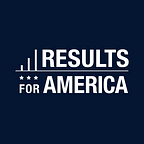Lessons Learned from the CARES Act: Rethinking Support for America’s Workforce
By Jack Monahan
In March of 2020, a once-in-a-generation economic downturn and unemployment shocked the United States alongside the coronavirus pandemic. The CARES Act, legislation written to reverse the damage done to America’s workers, has changed how some are thinking about how we get people back in jobs that support their wellbeing, families, and communities.
Seema Jain, a Workforce Fellow with Results for America, Vice President of Operations and Contract Monitoring for the SkillSource Group, Inc. and Deputy Executive Director for the Virginia Career Works — Northern Region, spends her time ensuring that Virginians are able to get jobs and meaningful employment as fast as possible.
In addition to stimulus checks and increased unemployment benefits, the CARES Act allowed organizations like Seema’s to use 20% of WIOA dollars for administrative costs incurred in workforce investment activities. Jain’s team received $1.1 million to spend between August to December, a pretty tight timeline for her and her team to use the funding on services for their community.
There was a twist however — anyone economically impacted by the coronavirus outbreak was eligible, a much larger number of people than those traditionally served under WIOA. A larger pool of applicants for workforce services meant rethinking how to get as many people through the system as possible. Wider eligibility and the shortened time frames remained challenges for using the CARES Act funding, but those same challenges allowed for faster processing of applications and helping people get into jobs sooner.
In this case, necessity was the mother of invention. While the CARES Act allowed for a massive increase of individuals seeking support from workforce services, its broader eligibility also meant less documentation and red tape to get people into their system. The biggest and most immediate benefit that Seema’s team achieved was shortening the application process from twelve pages to three. The increased accessibility and ease of the new application process — including the shortened amount of time required to fill out paperwork — meant more people got the services they needed in record time, without losing any quality of those services. Something as simple as an application’s length has huge implications for those served by the workforce development system. These improvements in how services are accessed show the tension in the public workforce system between availability of services and compliance with legal requirements.
As harsh economic realities continue, these lessons learned through the implementation of the CARES Act make a clear case for improving and increasing access to the U.S. workforce system. A revitalized workforce system is possible through the reauthorization of WIOA, especially through the use of data and evidence. Results for America’s Moneyball for Workforce Development, released in 2020, offers transformative solutions that could enable the reauthorization of WIOA to catalyze a truly evidence-driven public workforce system. At a time when workforce development services are needed more than ever, and with the potential for additional stimulus funding to support these efforts, these smaller changes to how we are able to return workers to the labor market shed light on the impact that larger changes could have on our workforce system.
Jack Monahan is a Team Assistant at Results for America
